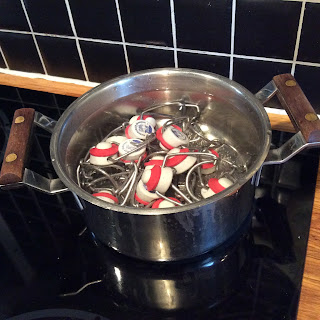As you may have read, a not-so sneaky apple thief came a-scrumping a month or so ago and I had no apples. Fortunately a friend, actually two friends, came to my rescue and rekindled my cider-making motivation. One friend knew where we could get some apples, and the other had the right kinds of bottles to store the maturing cider. If you know where you can get these two things, then you might benefit from my simple step-by-step instructions for how to make your own cider.
1. Get apples
We did not have the means to weigh our apples, but an educated guess puts these three boxes at around 60kg. They are autumn apples, as summer apples like the Transparence Blanche that my scrumping thief stole from my garden are no good for making pressed apple juice. Apparently they just bruise and taste bad.
2. Press apples
In Sweden you can look up your local musteri or juice press. For a small fee per litre they have the capacity to press the apples quickly and efficiently. We pressed ours at Vårdsätra Musteri and they produced 40 litres or delicious juice, ready to drink or brew into cider. You can press the apples yourself, there are plenty of tutorials online, but you need extra materials and lots of space and these factors put me off. It's supposed to be simple!
3. Freeze the juice
4. Buy yeast, a water lock and a siphon
As for yeast I bought Safcider Yeast for Cider because it was cheap and had a good tempearature range. My bathroom is always 20 degrees and that's right in the middle of this yeast's range.
I also bought 1 metre of plastic tube to use as a siphon, which is really useful for transferring the cider from the big bottle to small bottles without all of the yeasty crap following along.
If you live in England, you can buy all of these things really, ridiculously easily. Even Tescos and Wilkinsons sell home brew kits.
5. Add sugar and yeast to the apple juice
If you want to be precise, you can also buy a Hydrometer to measure the alcohol content of your cider and to work out how much sugar needs adding.
If you are impatient, like me, and just want to see how it turns out, then add some white sugar (I added 100g to my 5L batch, I will let you know how it turns out!) to your apple juice and then add some yeast (a 5g packet like the one above is good enough for 20-30 litres) and then guess how alcoholic it is at the end when you drink a bottle and fall over (or not.) According to some websites, if you add no sugar at all you will end up with 5-6% alcohol in your cider.
Put your airtight waterlock on the bottle.
6. Let it ferment for 1-2weeks
I left mine in the bathroom for 10 days at 18-20 Degrees. I knew it was working because some froth formed (and left the brown smudge on the neck of the bottle) and for a few days in the middle you could hear the "sploop" of the air escaping from the lock. After 10 days I knew it was done because the air sploops had stopped.
7. Sterilise some containers to put the cider in
 I was able to get my hands on some Czech and German beer bottles with resealable rubber/metal/ceramic lid contraption dealies. I boiled the lids to sterilise them, for 10 minutes on a rolling boil.
I was able to get my hands on some Czech and German beer bottles with resealable rubber/metal/ceramic lid contraption dealies. I boiled the lids to sterilise them, for 10 minutes on a rolling boil.As for the bottles themselves, I soaked them in soapy water for 10 mins to remove the labels and then baked them for 20 minutes at 120 degrees to sterilise them.
I let them cool completely before putting any cider in them!
Some people re-bottle the cider in another large container and let it sit a bit longer before bottling, just to get rid of the dead yeast and make sure the cider is really ready.
Since my cider had completely stopped making any bubble noises, I decided to put it straight into bottles. This may or may not be a giant mistake, watch this space...
I took the bottling process as an opportunity to try the cider and it tasted ok, like the old man mentioned above but maybe not quite wizened. I hope me comparing the taste of cider to the taste of an old man isn't putting you off completely.
And now I wait, to see if some time sitting in bottles in my basement will make the flavour mature at all, or just turn all my hard efforts into vinegar.







No comments:
Post a Comment